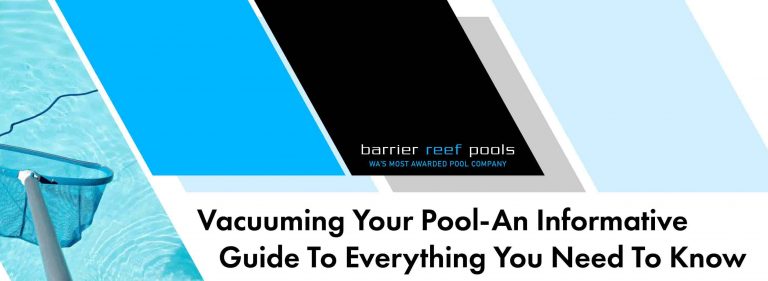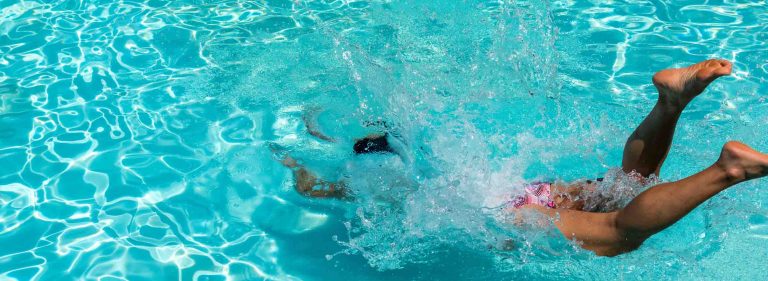Your swimming pool can get really dirty if you don’t follow the right cleaning practices. Outdoor pools in particular are at risk of getting clogged with sand, leaves, flowers, dust, dead bugs and other debris.
A pool vacuum system can help you keep your swimming pool clean and fresh. In this article, we’ll take a deep dive into fiberglass pool vacuuming.

What is a pool vacuum?
A swimming pool vacuum is an equipment that has been designed to clean debris that’s sunk down onto the pool’s floor. Just like a normal vacuum cleaner, a fiberglass pool vacuum can clear away both small and large particles of dirt, keeping your swimming pool clean and clear.
Benefits of pool vacuuming:
Pool vacuums prevent algal build-up
Vacuums can get rid of algae very quickly, preventing build-up of algae in your pool. Regular vacuuming can also prevent the build-up of water-borne pathogen colonies as well, by preventing water form remaining stagnant (a real problem when you don’t use your fiberglass pool often).
Pool vacuums improve your pool’s aesthetics
Imagine you’re having guests over. What kind of an impression would a debris-filled swimming pool give? A single session of vacuuming can effectively get rid of all the contaminants in your pool, making it look absolutely clear and stunning.
Pool vacuums increase your filter’s longevity
Your pool filter ensures your water is always clean and free of dirt and contaminants. But if there’s too much debris, they can clog-up your filter, stopping it from working. A pool vacuum can remove the larger debris which can affect your filter’s operation and usage life.
Pool vacuums ensure water purifying chemicals spread to your entire pool
Purification chemicals like chlorine and non-chlorine powders stick to pollutants to neutralize them. But if there are too many contaminants, these chemicals may remain lodged in just a few areas of the pool, without properly dissolving and mixing into the entire pool water. Vacuuming helps remove heavy and large pollutants that can disrupt the efficiency of purification chemicals.
Additionally, as the vacuum operates, it circulates the water at the bottom up to the top, ensuring any chemicals you’ve added, are properly mixed into the pool water.

Types of pool vacuums you can choose from:
Based on how they work, you have four types of fiberglass pool vacuums to choose from:
Manual vacuum
Manual pool vacuum cleaners are those which you manually move around to vacuum the bottom of your pool. They are actually the most cost-effective of all pool vacuum types and they’re great if you’re on a shoestring budget. They have a vacuum head which is attached to your pool pump through a hose. It’s also connected to a separate can to collect the debris.
But beyond this, manual vacuum cleaners don’t come with any high-tech features. You’ll need to expend a lot of energy to overcome the pushback from the water, while you vacuum the pool floor. Plus, you’ll need to clean the pool slowly, to prevent the debris from getting kicked up into the water – this will make your work harder.
Pressure-side vacuum
Another automatic pool vacuum that you can consider is the pressure-side vacuum cleaner. This vacuum cleaner is attached to the pump, where the pressure of the water being pumped into the pool is used to move the vacuum around on your fiberglass pool’s floor.
Unlike the suction-side vacuum cleaner, the pressure-side vacuum cleaner cannot transport your debris into the filter. Instead, they have a separate cannister connected to the vacuum, into which the debris is pushed.
Sometimes, your pool pump may not be strong enough to propel the pressure-side vacuum cleaner to all areas of the pool. You may need to invest in a booster pump for extra power, which may overall cost you a little higher than the suction-side vacuum cleaner.
Suction-side vacuum
Suction-side pool vacuum cleaners use the power of your pool’s filter, circulating pump and skimmer to clear out any debris. This is an automatic pool vacuum cleaner, which can be dropped into the fiberglass pool, where it suctions in any debris that floats by.
The vacuum automatically moves along the floor of the pool in a circuit. The debris is suctioned into the pump basket and thrown out through the filter. While smaller particles easily pass through, larger debris such as leaves, rocks or paper may get lodged inside the filter or skimmer. You’ll need to regularly clean these parts to ensure your vacuum runs efficiently.
Suction-side pool vacuums are more expensive than manual pumps. But they are a reasonably-priced and an affordable option if you want an automatic pool vacuum cleaner. Of course, you also need to remember that you may need to replace your filter often because this vacuum puts more pressure on it to work.
Robotic vacuum
Robotic vacuum cleaners are the most cutting-edge type of pool vacuum cleaners. They use state-of-the-art components to give you the most effective pool deep clean.
Unlike the other vacuums on our list, robotic vacuums aren’t connected to any other pool component such as the filter or pump. Instead, they contain special parts which perform the role of a filter, when in use. You only need to connect the robotic vacuum to an electrical outlet and the vacuum will move along using its built-in motors and use its built-in filter to suction in the debris.
Robotic vacuum cleaners come with a really long cable and are powerful enough to clean pools that are 50ft long. But because of all these advanced features, robotic cleaners are the most-expensive and unsuitable if you’re on a budget.
How often should you vacuum your pool?
Best practice is to vacuum your pump once a week, every week. However, you should vacuum it more often if you notice that your pool is particularly dirty (especially after heavy showers or snowfall).

Tips and tricks to vacuum your pool the right way
- If there are any faeces in the pool, use a net to get it out. Faeces can clog your vacuum, pump or filter and should never be vacuumed out.
- Choose your filter setting based on how much debris needs to be cleared out. If there is less debris, then you can use the “Filter” setting and allow the water to be passed through to the filter from the vacuum. But if there is a lot of debris (especially large debris), it’s best to select the “Waste” setting. This will vacuum the dirty water directly into your drainage pipe and throw it out. When in the “Waste” setting, you’ll lose a lot of water from the pool. Plop a garden hose down into the pool and keep topping-up the water to ensure your fiberglass pool doesn’t run out of water.
- Move the pool vacuum in straight lines. Stop a few times to clean out the debris in the pump, skimmer or filter. Always vacuum in two rounds, but the second time, replace the head with a brush. This will remove the stains and give your pool a bright shine.
- When you’re done with the vacuuming, clean out the pump, skimmer and filter with care. There may be large debris lodged there. Additionally, store your vacuum away after you’re done, as this could be a tripping hazard if you leave it in the pool.
- Keep your vacuum head submerged in the pool during the entire time you vacuum the pool.
- Switch off all the skimmers, except the one you’re planning to use, before beginning the vacuuming.
- Air in the hose stops water from being pumped into the pool, which can affect how your pressure-side vacuum works. So, place the vacuum hose against a jet of water until you stop seeing any bubbles forming in the hose. You can also slowly uncoil the hose by submerging in the water. This ensures there’s no air build-up in the hose when you attach it to the skimmer.
- If the debris is too large, such as very big leaves, large rocks or mounds of mud, then use a net or leaf trap to get them out. Your vacuum should be used to remove only small-to-medium sized contaminants.
- Never vacuum when someone is in the pool. The force of the vacuum in the water can cause injuries to the person using the pool.
- After finishing pool vacuuming, use a water testing kit to check your pool’s pH balance. The swirling motion of the water and the removal of debris will have altered its chemical composition. By checking the pH balance, you can do what is necessary to bring your water back to its normal state.
Need more tips about pool vacuuming?
Our team at Barrier Reef Pools Perth can advice you about:
- Choosing a pool vacuum that fits into your budget and is well-suited for your fiberglass pool.
- Using your pool vacuum cleaner in a safe, efficient and economical way.
- Maintaining clean, clear and healthy pool water that everyone will enjoy taking a dip in.
If you already don’t have a fiberglass pool, our experts can quickly install a gorgeous pool in your backyard. We offer very competitive prices. Speak to us for more information.



